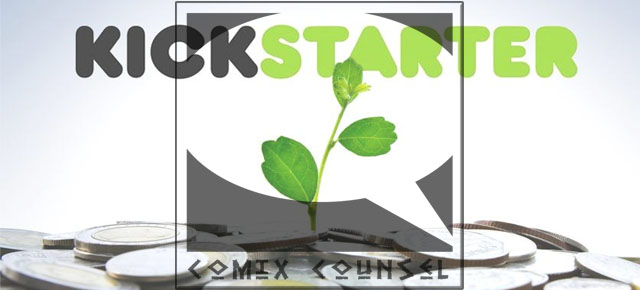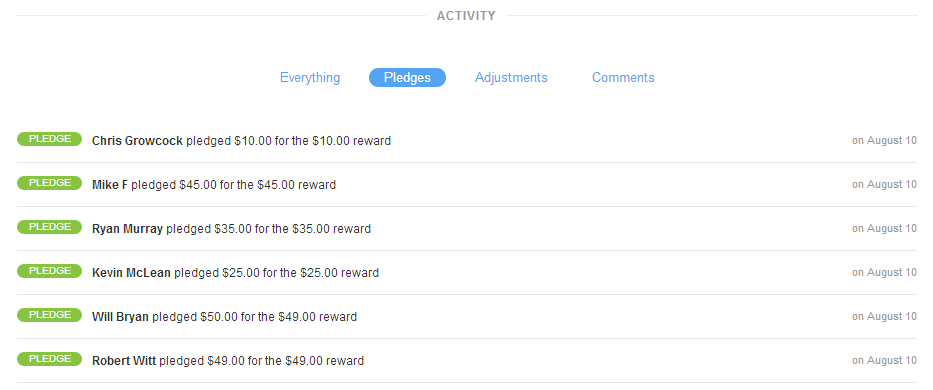5 Ways Kickstarter Can Be Better
 As readers of this column know, back in August I ran a successful Kickstarter campaign. The word game-changer is probably overused, but for the creative entrepreneur, it’s hard to describe the rise of crowd-funding platforms as anything but. Prior to running the campaign, I shared what I thought I knew about the phenomenon going into it, and also detailed how I was going to approach running a campaign. And when it was all said and done, I shared some key lessons learned from a successful campaign.
As readers of this column know, back in August I ran a successful Kickstarter campaign. The word game-changer is probably overused, but for the creative entrepreneur, it’s hard to describe the rise of crowd-funding platforms as anything but. Prior to running the campaign, I shared what I thought I knew about the phenomenon going into it, and also detailed how I was going to approach running a campaign. And when it was all said and done, I shared some key lessons learned from a successful campaign.
Kickstarter (and other crowd-funding platforms), at least for the foreseeable future, are here to stay. And while they have been a game changer, what I’d like to offer today is some suggestions for how they can get even better. I’ve been impressed that the Kickstarter development team seems to be on-the-ball, and works to improve the platform on a daily basis. I’m sure many of the items on my wish list are things that they have considered internally, and for all I know are working on.
And before I launch into my suggestions, I want to give some kudos to Kickstarter for some improvements they’ve already made since I launched my campaign, such as adding the Risks and Challenges section as a requirement on the page templates, to address the issue of accountability. They’ve also improved navigation to see order information from backers. For example, it’s now easier to access full order information from backers when they send you messages. Continuous improvement is clearly on the KS team’s agenda.

Kickstarter Employees
Now, I understand that part of the appeal of Kickstarter is its simplicity. And some of these features would add complexity to the platform. But, as Kickstarter matures, so will its users and I strongly believe many of these changes would empower us to run even better campaigns.
I. Support Add-On Product Sales
While most Kickstarter campaigns are geared toward selling one core product (in my case the Oxymoron hardcover), it’s clear that campaigns are a great opportunity to sell bundles of a variety of products. Kickstarter allows users to create as many different packages and pledge levels as they want, but it also requires each backer to be able to have one and only one pledge level.
This can be problematic when you have a lot of great products, especially when some of them are limited in nature. For example, we had a backer grab a Joe Mulvey sketch package which was limited to four and sold out in a day. But later in the campaign, we offered another package to get original art from the book. The backer wanted a piece of original art, but didn’t want to lose his Mulvey commission. (And who can blame him, Joe’s art rocks!)
Now, in this case, I was able to work out a deal with the backer through email, and he upped his pledge to get both items, which isn’t an awful option. But I do feel dollars are being left on the table by not allowing campaign managers to offer both core pledge levels, and additional add-ons that could be added to any pledge level.
The easiest time to sell something to someone is when they already have their wallet open. A convenient add-on system would no doubt up the dollars raised in campaigns, and lessen the management burden for campaign managers to keep track of custom and hybrid pledge rewards.
II. International Pledges Support
While Kickstarter often seems like a dream come true to successful campaign managers, for some it will be a nightmare. And in most cases, a big part of the nightmare will be the failure to adequately factor in the cost of shipping, and in particular, international shipping.
Make no bones about it, kids, shipping is no fun. It’s more time-consuming than you think, and it’s a lot more expensive than you think.
*POP QUIZ: How does it cost to ship a hardcover graphic novel to Australia? (Answer at the bottom of the column.)
Right now, I’m seeing four main approaches to how people are handling international shipping in their Kickstarter campaigns.
A) They’re not factoring it in at all. (Huge mistake!)
B) They’re adding a note at the end of each pledge level that says Kick in an extra $XX for international shipping.
C) They’re separating international shipping pledges into their own pledge levels, and adjusting their price accordingly.
D) They are posting in their campaign an elaborate matrix that tries to show in the pledge level, the shipping destination, and the amount of extra money needed to pledge.
For my campaign, I chose Option C. But to be honest, I feel all the above methods are lacking, and that there should be a better way to automate this. Right now, there’s nothing forcing an international backer to add those extra dollars, and many campaigns end up having to go into collection mode after the fact. And the add an extra $10 method is pretty inaccurate. It might cost and extra $3 to ship something to Canada and an extra $21 to Germany we’re all hoping that it averages out in the end, but hope isn’t something I want to rely on.
So, what’s the alternative?
Well, presumably Kickstarter knows where every backer is coming from when they register. Perhaps a better option would be to allow campaign creators, for each pledge, to customize what the add on is for as many regions as they like. So, I might have put my main Oxymoron hardcover pledge at $25.00. While setting that up, I could designate an extra $5.00 for Canada/Mexico, $15.00 for Europe, $20.00 for everywhere else something like that. If you’re in the US, you’ll see US pricing, but if your coming from outside, you’ll see the international price and have to pledge at that level.
III. Net Profit Estimator (and Other Project Planning Tools)
In running my campaign, I’ve made about a half a dozen spreadsheets, all in an effort to try to not go broke running this damn thing. With Kickstarter, we tend to focus on a few key numbers the biggest being the total campaign amount raised. But we all know that’s not how much money you’re going to make from the campaign, and that number can be very misleading to your bottom line.
Another advanced tool that would help creators keep a realistic notion of how well they are doing would be a real-time net-profit estimator. Here’s what I mean:
– Every pledge level has a cost to it, that at bare-minimum equals the Kickstarter/Amazon.com fee ~9.1%. That would be the cost of a digital only reward, for example.
– But, for a $25.00 hardcover, additional costs would include: shipping, packaging, and the cost of the book itself.
– Many projects have some fixed-costs as well: cost of the print run, paying the creative team, advertising, storage, etc.
What I’m envisioning is a real-time tool that would update automatically during a campaign, giving a manager a more accurate picture of how much (if any) profit he or she will be raising from the project.
And FYI, the Oxymoron campaign raised $26,000, more than three times our project goal. However, as the campaign continued to grow, we continued to add value (and cost) to the project (variants, bonus comics, prints, bookmarks, etc.) I’m hoping that with strong sales after the campaign, this book will eventually turn a profit. (Damn, there’s that hope word again.) Now, as the campaign went on, I did my best to run the kind of calculations I mentioned above but having an automated one on Kickstarter would have made my life a hell of a lot easier.
IV. Quick Reply Feature
Okay, this is a little one, but an EASY one, that I hope Kickstarter will jump on. It feels awful saying this, but I was unable to personally thank every single backer to my campaign with a quick message. Yes, Kickstarter makes it easy to message backers. And when you’re sitting at the computer and see a new pledge come in, sure, it’s easy to fire off a quick thank you.

A quick reply option under each backer as they come in would be a big help!
But, when you go to bed and wake up and there are 25 new pledges then it gets a bit difficult. Kickstarter gives you a screen that lists in chronological order all of the pledges. And from that screen, there is a MESSAGE button for each person. But that button takes you away from the list screen, and then getting back to that list screen takes a few more clicks. And when you’re back there, there’s not record of that last person you messaged.
Now, this might sound like a ridiculous first world problem (and it is) but there’s a simple solution: a quick reply feature on this list, which will allow users to send a quick note to anyone on the list, WITHOUT LEAVING the list. A record of the message history should also be shown and updated on this list.
Easy right? Get on it, Kickstarter!
V. Campaign Manager Feedback and Power Backer Rewards
The so-called Kickstarter bubble will not burst but it might self-destruct. What I mean by that is the biggest danger to crowd-funding is the perpetual over-promising and under-delivering of campaign managers. In other words, if Kickstarter fails, you and I will be to blame.
And there is real danger here. I’ve read anecdotally that some 60-70% percent of all-Kickstarter project rewards are delivered late. It kills me to say it, but I’m no exception. Though my project was finished on schedule and I gave delivery estimates in good faith, it took about a month longer than expected to get our books on the presses. (We did deliver our digital reward on time, however, and I’m expecting the books any day now!) Chronic lateness and under-delivering on promises will lower the enthusiasm for Kickstarter projects…and KS is a platform that only thrives on enthusiasm.
But an even bigger danger is the high-profile bust , where a project enjoys wild success and the creator disappears with the money, never delivering on those pledges. There’s simply too much money being raised and too many scammers out there in the world for this to NOT happen.
While bubble may be too strong a word, and I feel like Kickstarter will only continue its rapid growth in popularity and awareness over the next few years, we may still be in a novelty phase , where the idea of paying usually a little more than we’re used to , for a product that doesn’t exist yet, and most likely won’t arrive when the creator says it will, hasn’t lost its luster. There’s as much trust and faith being extended on Kickstarter as there are dollars, and trust is not an inexhaustible resource.
As Kickstarter matures, potential backers are going to get more savvy. Brett Schenker of Graphic Policy, after having a number of projects he recommended on his site fail to meet shipping deadlines, has started including a RISK rating for crowd-funding projects that he blogs about. I think Kickstarter should embrace this idea, and follow the Ebay model of establishing a project manager rating system.
At some point after the completion of a project, backers should be encouraged to rate and/or leave feedback on project manager. We’re already seeing Kickstarter veterans, guys like Jimmy Palmiotti, whose recently successful Sex and Violence Kickstarter makes his third successful project in the last year and a half. Wouldn’t potentially backers like to know how well Jimmy has been able to satisfy his previous backers? (Considering each project has raised more than the last, I can only assume Jimmy is doing well in that department.)
I think this is something that could really help the Kickstarter community. A manager rating system would help keep project managers from abusing the system, and hold them accountable to the people who supported them. As Kickstarter is more and more becoming a place where people are discovering new talent, it’ll also provide a greater sense of how much risk backing a stranger’s project carries with it.
And on the flip-side, as Kickstarter matures, it should start rewarding the people who keep it in business the Backers. It’s true, supporting Kickstarter projects is its own reward it’s that potent combination of altruism with goodies that makes it such a tempting way to buy things. But why doesn’t Kickstarter encourage backers just a little more?
Imagine this Upon backing your tenth successful project, Kickstarter sends you a coupon for $10 in KS Bucks, which can be spent on any one Kickstarter project. On your 25 backed project, you get $25. 50th, $50 and so on.
Now, some of you are going to say but that can be gamed, right? Just back 10 projects at $1 a piece, and you’re breaking even. Which is true. But, if you can only use the $10 once, and if it gets used regardless of a project’s success, and the average success rate is still around 50%, that would suggest half of all of these coupons wouldn’t actually cost Kickstarter anything. And if they were used, that backer now has more of an incentive to want to see that project succeed and therefore promote it harder, perhaps. And what’s more likely to happen is that you’d use a coupon at one price level, and upgrade to a higher level.
Anyway, this is just one sort of promotion that I’d like to see Kickstarter do. I’d like to see backers start earning more rewards from Kickstarter itself (who are profiting nicely, by the way). This will encourage more active browsing of Kickstarter, rather than waiting for a cool project to show up on your social media streams.
Alright, I’m 2,000 words in. Those are the five things on MY Kickstarter improvement wish list. What’s on yours? How can Kickstarter and other crowdfunding platforms do what they do better. Let’s discuss!
* USPS First Class Shipping to Australia – $14.74. Tracking isn’t available at that rate. If you want tracking, it’ll cost you $46.75.
Related Posts:
Category: Comix Counsel

















I’m sure KS would value this feedback. I’m interested in the risk rating of PMs/projects. Fiverr, a site where people “ship” for 5 bucks has a rating system for their sellers and incentives to sell.